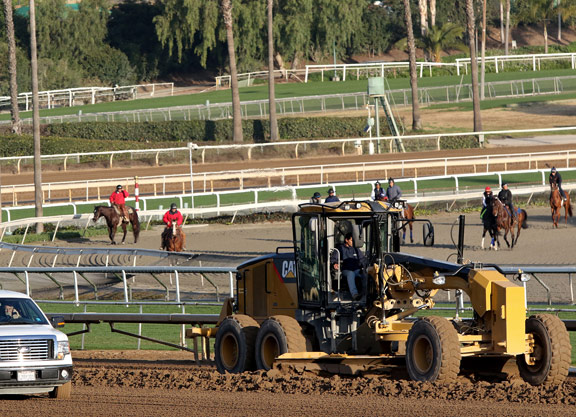By Dan Ross
After two quiet days, the training track at Santa Anita re-opened Friday morning—an obvious relief to those trainers whose horses have been restricted to exercise around the barn.
But at the forefront of many minds among those present at Santa Anita early Friday morning was the issue of what safety protocols, other than track maintenance, will be instituted to reduce the high fatality rates that have marred the track's current winter-spring meet.
Indeed, this issue was raised at a trainers meeting Friday morning at Santa Anita, said California Thoroughbred Trainers executive director, Alan Balch.
“There's no question that the attention is on horsemanship and preparation of horses, and everyone needs to be extremely careful, even in sending horses out to jog, gallop and everything else,” said Balch, when the meeting concluded. “It should go without saying, with an abundance of caution we want to make sure that trainers have a heightened sense of responsibility.”
Balch also said that the horsemen had an “extended conversation” about a number of other safety and racing-related issues, including the condition book, numbers of races, race distances on turf, and intimidation of horsemen to run.
“We as an organization do not have the authority to approve the condition book,” Balch added. “Our understanding is that the [Thoroughbred Owners of California] shares our concerns about number of races, use of the turf course, and the levels of races being run.”
On Thursday, TDN spoke with California Horse Racing Board (CHRB) Executive Director, Rick Baedeker, who explained that Santa Anita and the CHRB could employ a similarly rigorous version of safety initiatives instituted at Del Mar in 2017 to tackle the high numbers of equine fatalities that occurred the year prior. “Reinvigorating the program that was implemented at Del Mar is apparent to all of us,” he said.
Though many of the same initiatives are already in place at Santa Anita, officials explain they haven't been enforced as intensely as at the San Diego venue due to a shortage in official examining veterinarians.
In response, Tim Ritvo said that Santa Anita has never been notified about the shortage in examining veterinarians.
“We have state protocols that say horses need to be examined, and if they're having trouble getting vets, I would hope they notify the association,” Ritvo said.
He stressed the importance of trainers making sure they don't run horses that are “not in good condition,” and added that “we're doing every test possible, and every possible protocol on the track, to make sure we're 100 percent the safest surface we can be. The same for all our tracks.”
During the 2016 summer meet at Del Mar, 17 horses were fatally injured during training and racing. During the 2017 summer meet, that number was cut to five. These numbers were again relatively low during last year's summer meet.
Perhaps the most visible step that Del Mar took in 2017 was to employ veteran track superintendent Dennis Moore to reconfigure the dirt surface to match the geometric shape of Santa Anita's main track.
On top of that, the facility used the Jockey Club's InCompass system to provide a daily itinerary of horses that fell within two categories: horses that hadn't raced for a period of 120 days or more, and those that hadn't started before four years of age or older. That same list also included other important information, like whether the horse had previously been on the vet's and Steward's lists, as well as the date of its last two workouts, the distances and times.
Two additional state veterinarians were drafted in to assist the usual team of official veterinarians to routinely monitor horses flagged a relative risk of catastrophic injury. By the time any flagged horse made it to the usual pre-race examination, they had been seen-typically multiple times-in the preceding weeks and months.
As an additional layer of scrutiny, past performances were pulled on entry day, to identify other horses not included on the daily InCompass list, but whose profiles caused concern. This included horses being dropped in claiming price, and those shipping in from Northern California or out-of-state—horses that hadn't been previously examined by the track or state veterinarians.
What's more, the horsemen along with a state veterinarian and safety steward posted on the grounds seven days a week were asked to keep their eyes peeled for any warning signs during training. Interestingly, two official veterinarians were posted at the Santa Anita training track Friday to watch morning exercise.
According to officials, many of the same procedures employed at Del Mar have been in place at Santa Anita. For example, the InCompass system is still used to produce the same list of possible at-risk horses for added scrutiny.
However, these same officials explained that a reduced number of official veterinarians at Santa Anita, as compared to Del Mar, meant these flagged horses weren't examined as frequently. At Del Mar, for example, a state veterinarian was situated on the racetrack grounds seven days a week. At Santa Anita, an official veterinarian was only required to be on the grounds five days a week.
Balch expresses surprise that the safety measures instituted at Del Mar weren't enforced as vigorously at Santa Anita. “That's a surprise, as I thought they were. I don't know why they wouldn't be,” said Balch.
“I thought that was standard operating procedure for the racing board now,” Balch added. “We support that [same intensely enforced set of safety policies] 100%.”
Baedeker admitted that a lack of personnel at Santa Anita made the program difficult to maintain at the same level as at the San Diego venue. “Admittedly, we haven't had as many state veterinarians examining the horses as we used to during the Del Mar meets, but that's a scenario that can be addressed, and will be,” he said. “There's going to be expense involved, but that's fine, we have no choice.”
One of the biggest benefits of the intensive pre-race examination system, said Baedeker, was the increased awareness it generated. “The trainers became more used to it,” said Baedeker. “They may not have known a horse they had gotten a month ago had issues. Then they were.”
Baedeker stressed the up-in-the-air nature at the moment behind any possible alterations to safety and integrity protocols at Santa Anita. Mirroring Balch's comments, Baedeker flagged the Santa Anita condition book as a possible place for change—”restrict the condition book to a degree, so that certain horses in certain races aren't run,” he said.
Baedeker also raised the possibility of curbing the races on a card to a “reasonable” number. “Those 11 race cards may not be appropriate,” he said.
Baedeker said that the state “can only do so much,” and that “we really need the association to step up. All indications show they are, and they're willing to do what they can going forward,” he said.”
He added that the CHRB is eager to hear “any idea” that could be employed as a potential fix. The next board meeting is scheduled Mar. 21. “In terms of board action, anything and everything is on the table when it comes to solving this problem,” he said.
Not a subscriber? Click here to sign up for the daily PDF or alerts.






